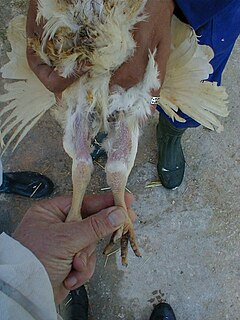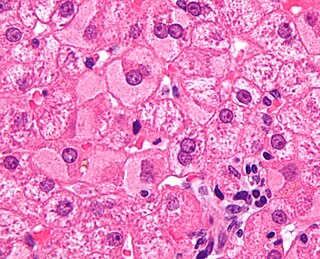Humans
Viral arthritis in Humans (also see: arthralgia) can be caused by:
Arthralgia literally means joint pain. Specifically, arthralgia is a symptom of injury, infection, illness, or an allergic reaction to medication.
- Parvovirus, especially parvovirus B19
- Hepatitis B
- Hepatitis C
- Rubella
- Alphaviruses
Parvovirus is the common name applied to all the viruses in the Parvoviridae taxonomic family, although it can also be used specifically for members of one of the two Parvoviridae subfamilies, the Parvovirinae, which infect vertebrate hosts. Members of the second subfamily, the Densovirinae, which infect invertebrate hosts, are more commonly referred to as densoviruses. In subfamily Parvovirinae there are eight genera, containing a total of 58 recognized species, while in subfamily Densovirinae there are 5 genera and a total of 21 species. These viruses have small genomes, encoding just two genes, and must rely on the synthetic machinery of their host cell for their own preferential replication. This means that many parvoviruses require host cells to enter S-phase before viral DNA replication can initiate, but they do not encode any gene products that can drive this transition. Parvoviruses overcome this problem in various ways: viruses in many genera simply wait within the cell for it to enter S-phase under its own cell cycle control, which means that they can only infect actively-dividing cell populations. In contrast, the so-called adeno-associated viruses (AAVs) from genus Dependoparvovirus must wait until the cell is co-infected by a helper DNA virus, commonly an adenovirus or herpes virus, which does encode gene products that can drive the cell into S-phase, allowing AAV infection to initiate and out-compete the helper virus. A third strategy is used by human bocavirus 1 (HBoV1) from genus Bocaparvovirus, which appears to invoke a specific DNA-damage response in its host cell that ultimately supports viral DNA amplification and progeny virus production.

Primate erythroparvovirus 1, generally referred to as B19 virus, parvovirus B19 or sometimes erythrovirus B19, was the first known human virus in the family Parvoviridae, genus Erythroparvovirus; it measures only 23–26 nm in diameter. The name is derived from Latin, parvum meaning small, reflecting the fact that B19 ranks among the smallest DNA viruses. B19 virus is most known for causing disease in the pediatric population; however, it can also affect adults. It is the classic cause of the childhood rash called fifth disease or erythema infectiosum, or "slapped cheek syndrome".

Hepatitis B is an infectious disease caused by the hepatitis B virus (HBV) that affects the liver. It can cause both acute and chronic infections. Many people have no symptoms during the initial infection. Some develop a rapid onset of sickness with vomiting, yellowish skin, tiredness, dark urine and abdominal pain. Often these symptoms last a few weeks and rarely does the initial infection result in death. It may take 30 to 180 days for symptoms to begin. In those who get infected around the time of birth 90% develop chronic hepatitis B while less than 10% of those infected after the age of five do. Most of those with chronic disease have no symptoms; however, cirrhosis and liver cancer may eventually develop. These complications result in the death of 15 to 25% of those with chronic disease.
Non-Humans
- Viral arthritis (poultry), an infectious conditions seen chicken and turkeys

Viral arthritis is an infectious condition in chickens and to a lesser extent, turkeys, due to a reovirus.

The chicken is a type of domesticated fowl, a subspecies of the red junglefowl. It is one of the most common and widespread domestic animals, with a total population of more than 19 billion as of 2011. There are more chickens in the world than any other bird or domesticated fowl. Humans keep chickens primarily as a source of food and, less commonly, as pets. Originally raised for cockfighting or for special ceremonies, chickens were not kept for food until the Hellenistic period.

The turkey is a large bird in the genus Meleagris, which is native to the Americas. Males of both turkey species have a distinctive fleshy wattle or protuberance that hangs from the top of the beak. They are among the largest birds in their ranges. As in many galliformes, the male is larger and much more colorful than the female.
| This disambiguation page lists articles associated with the title Viral arthritis. If an internal link led you here, you may wish to change the link to point directly to the intended article. |







